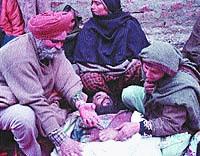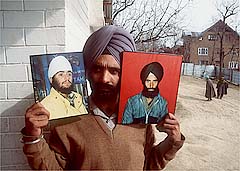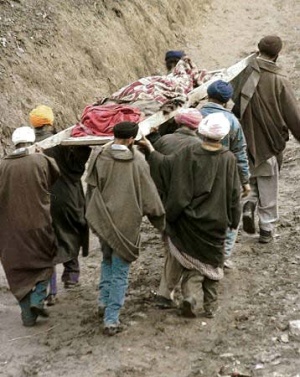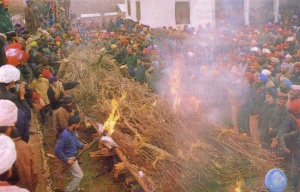Chittisinghpura Massacre: Difference between revisions
Allenwalla (talk | contribs) m (question - is USD 200 = $200 USofA currency?) |
Hari singh (talk | contribs) |
||
| Line 27: | Line 27: | ||
==The Clinton Controversy== | ==The Clinton Controversy== | ||
The massacre coincided with the visit of United States president Bill Clinton to India. In an introduction to a book written by Madeleine Albright titled, '' | |||
The massacre coincided with the visit of United States president Bill Clinton to India. In an introduction to a book written by Madeleine Albright titled, ''"The Mighty and the Almighty: Reflections on America, God, and World Affairs"'', (2006), President Clinton in the preface blamed the massacre on "Hindu Militants". The error created a major incident, with both Hindu and Sikh groups expressing outrage at the error. The President's office did not return calls seeking comment or clarification. In the hours immediately after the massacre in March 2000, the US condemned the killings but refused to accept the Indian governments contention that it was the work of Pakistan based Islamist groups. That changed as soon as Clinton's error was exposed. The publishers, Harper Collins routed a correction through Albright's office. In a public statement they acknowledged the error. | |||
Page xi of the book contains a reference to Hindu militants that will be deleted in subsequent printings, both in America and in international editions. This error was due to a failure in the fact-checking process. President Clinton has been known for making statements he later regretted. | Page xi of the book contains a reference to Hindu militants that will be deleted in subsequent printings, both in America and in international editions. This error was due to a failure in the fact-checking process. President Clinton has been known for making statements he later regretted. | ||
Revision as of 07:30, 15 March 2008
The Chittisinghpura Massacre refers to the cold blooded murder of 35 Sikhs, by unidentified terrorists though a member of the Islamic Fundamentalist militant group Lashkar-e-Toiba has confessed to his involvement in the massacre, which occured on the evening of March 20, 2000. According to Amnesty International, the massacre was linked to other massacres in the region where the people have doubted the government's account of the story. - See Amnesty International Report
The Killings
Wearing Indian Army fatigues to avoid detection the killers, in two groups, first lined the Sikhs, who had been celebrating the Hola Mahola Festival, up in front of the village's two Gurwaras and opened fire, resulting in a large number of deaths.
The sole survivor of the massacre was Nanak Singh, who was shot in the pelvis and laid unconscious on the pile of bodies. He recalled hearing the terrorists laughing over their deeds while sending a 'mission accomplished' message over their walkie-talkie. His son son Gurmeet Singh (16), brother Darbari Singh (30) and three 1st cousins were among the dead. His oldest son was away at the time.
The village did not have a telephone, some boys who came on the scene had to run 7 km, over a kuchha road, to reach a phone and summon help. As of 2007 Chittisinghpura was still not connected with a metalled road.
Lashkar-e-Toiba suspected
The residents were killed supposedly by LeT as part of their Islamist campaign in the region. A LeT militant named Suhail Malik of Sialkot, who was arrested in December of the same year, admitted, according to a rediff news report, to the involvement of the group saying he had no regret in perpetrating the anti-Sikh massacre. Malik apparently said he had opened fire because he had been ordered to do so by his commanders. He also said that he knew nothing about the plot to kill the Sikhs until he stood in an orchard where the 35 people were killed.
Lashkar-e-Toiba had taught Malik marksmanship and mountain climbing. He sneaked into India in October of 1999, with the equivalent of USD 200 in expense money, in order to participate in the massacre.
Aftermath
The killings of 36 Sikhs was a turning point in the Kashmir issue, as Sikhs had usually been spared of militant violence.
The villagers ensured that the local school was up and running just two weeks after the killings. The massacre created suspicion between the Sikh and Muslim residents of the area, but no problems developed in the joint Muslim-Sikh village school.
In 2005, Sikh organizations such as the Bhai Kanhaiya Jee Nishkam Seva Society demanded a deeper state inquiry into the details of the massacre and that the inquiry be made public. The state government ordered an inquiry into the massacre. A day after the inquiry was ordered, an NDTV special correspondent Barkha Dutt went to the village.
The Clinton Controversy
The massacre coincided with the visit of United States president Bill Clinton to India. In an introduction to a book written by Madeleine Albright titled, "The Mighty and the Almighty: Reflections on America, God, and World Affairs", (2006), President Clinton in the preface blamed the massacre on "Hindu Militants". The error created a major incident, with both Hindu and Sikh groups expressing outrage at the error. The President's office did not return calls seeking comment or clarification. In the hours immediately after the massacre in March 2000, the US condemned the killings but refused to accept the Indian governments contention that it was the work of Pakistan based Islamist groups. That changed as soon as Clinton's error was exposed. The publishers, Harper Collins routed a correction through Albright's office. In a public statement they acknowledged the error.
Page xi of the book contains a reference to Hindu militants that will be deleted in subsequent printings, both in America and in international editions. This error was due to a failure in the fact-checking process. President Clinton has been known for making statements he later regretted.
Mishra Controversy
The apparent error was aggrandized by Clinton's refusal to acknowledge it, and exacerbated by Pankaj Mishra's book, 'Temptations of the West: How to be Modern in India, Pakistan, Tibet and Beyond' , where he repeated the allegations against 'Hindu Militants' even after the confession of the Lashkar-e-Toiba militant.
Chittisinghpura massacre in film
The massacre was depicted in the commercial Bollywood film Adharm (unholy) directed by Adeep Singh.
Also View
- Clinton's thoughts on the Chittisinghpura Massacre
- Lashkar militant admits killing Sikhs in Chittisinghpura
- A Kashmiri Mystery
- Chittisinghpura murder of Sikhs : Letter from SAD (A)
- The massacre at Chattisinghpora
External links
AMNESTY INTERNATIONAL - India: A trail of unlawful killings in Jammu and Kashmir: Chithisinghpora and its aftermath
NEW YORK TIMES - A Kashmiri Mystery




